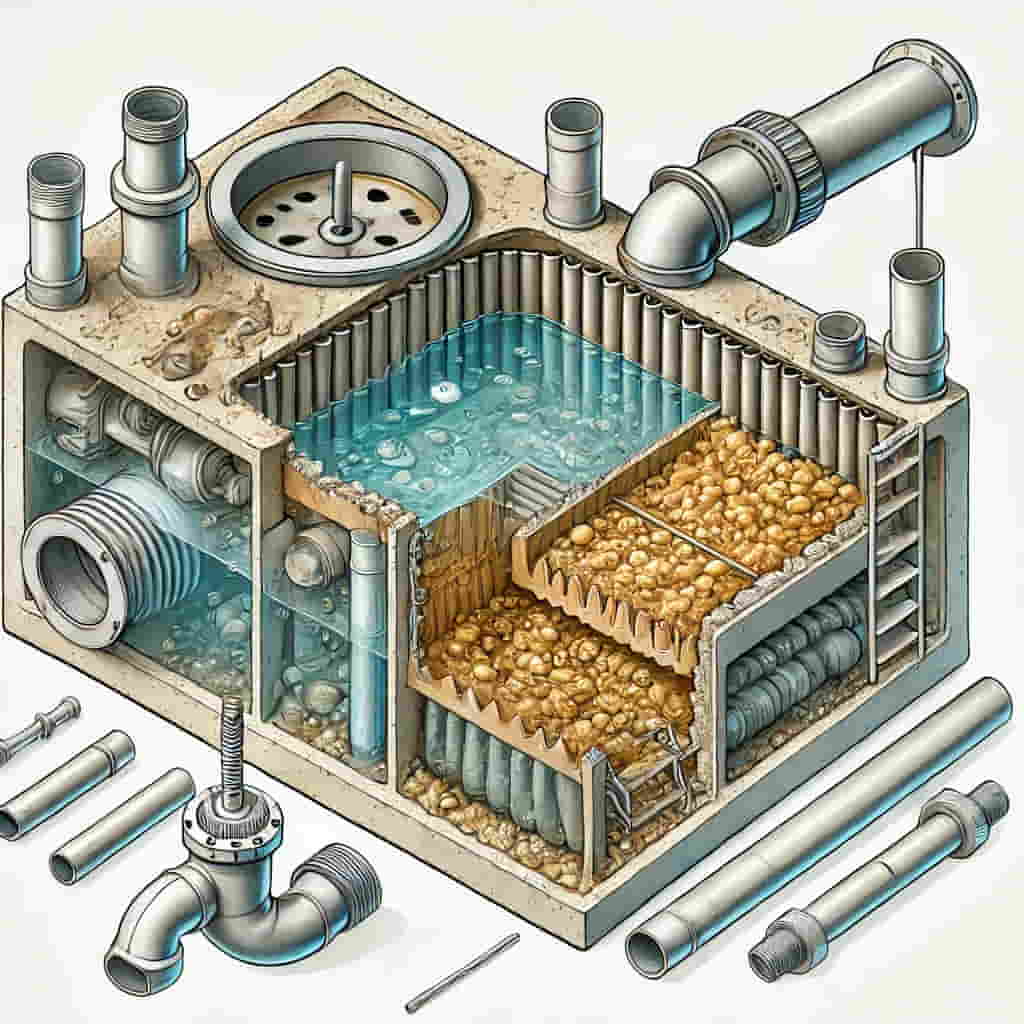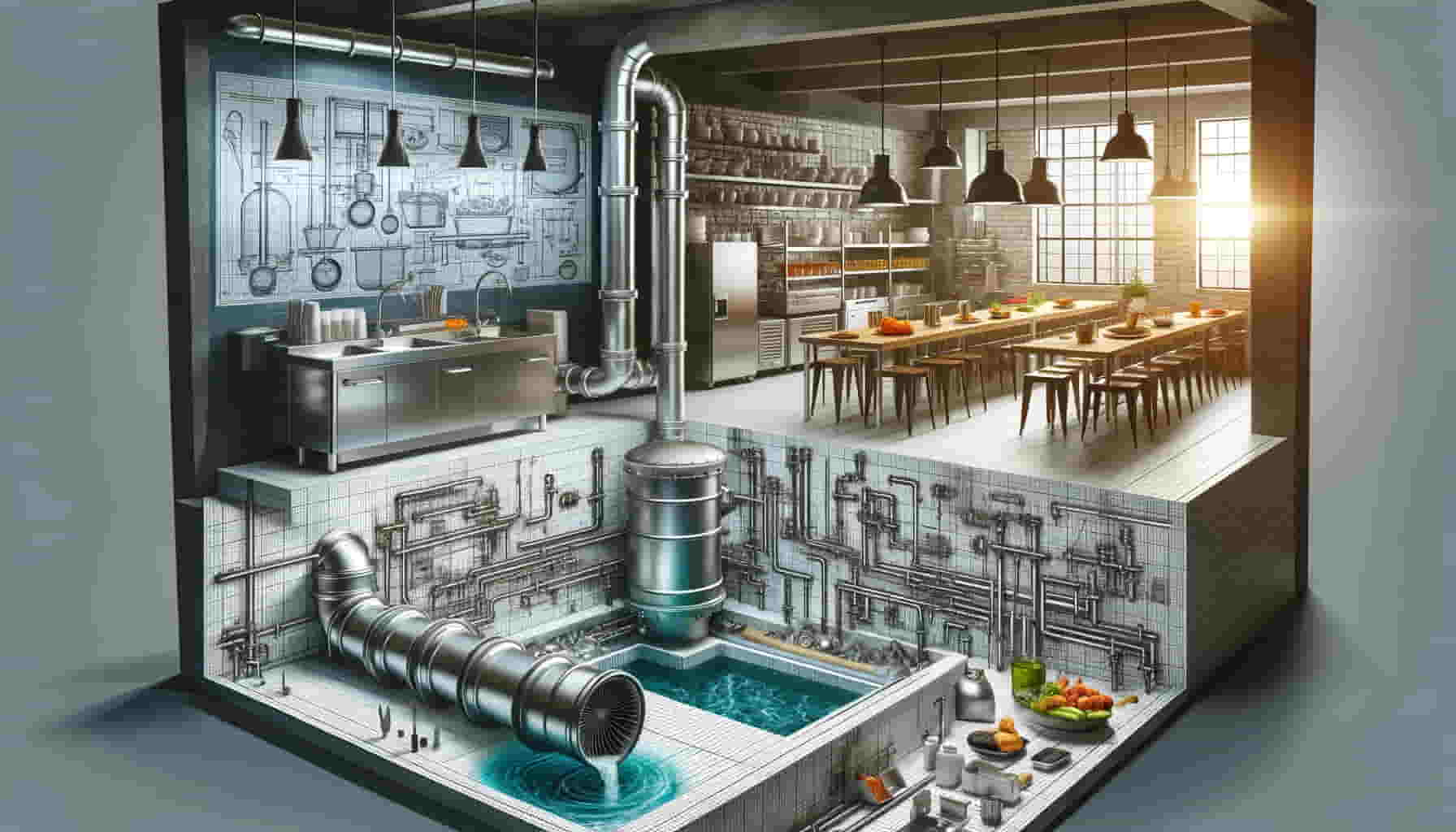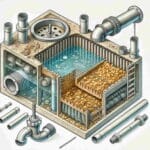Category Archives: Useful Tips
How to Choose the Right Grease Trap for Your Business
In the bustling food and hospitality industry, efficiency is everything. One crucial yet often overlooked aspect of maintaining a smooth operation is choosing the right grease trap for your business. With the proper setup, a grease trap can prevent clogs, improve kitchen flow, and keep you in compliance with local health and safety regulations. But here’s the catch: not all grease traps are created equal, and the best choice often depends on the unique needs of your business. So, what exactly should you consider when looking for a reliable grease trap service near me?
This guide dives into different types of grease traps, factors to weigh when choosing one, and practical tips on keeping your grease trap in peak condition. By the end, you’ll have a clear path to finding the best solution for your business.
Types of Grease Traps: An Overview
When it comes to grease traps, choosing the right type can make a world of difference. Let’s break down three main options and how they serve different needs.
1. Passive Grease Traps
- What They Are: Passive grease traps are small, often tank-like units installed beneath sinks or in floor drains. They separate grease and solids from wastewater by allowing them to float to the top.
- Pros: Affordable and relatively easy to install. Ideal for smaller kitchens or businesses with minimal grease output.
- Cons: These traps require regular manual cleaning to function effectively. If neglected, they can lead to blockages, odor issues, and even fines from health inspectors.
- Best For: Small cafes, bakeries, or food service businesses with low-to-moderate kitchen activity.
2. Automatic Grease Removal Units (AGRU)
- What They Are: Unlike passive traps, AGRUs automatically separate and remove grease from wastewater. They have a motorized skimming feature that collects the grease in a separate container, reducing the need for frequent manual cleaning.
- Pros: Highly effective and reliable, making them a favorite among medium-sized to larger kitchens. Their automatic features mean fewer maintenance hassles.
- Cons: Higher upfront costs and more complex installation requirements. They also require regular maintenance checks to ensure the skimming mechanism functions correctly.
- Best For: Medium to large kitchens, including bustling restaurants and hotels with a steady flow of greasy wastewater.
3. Grease Interceptors
- What They Are: Grease interceptors are large, often outdoor tanks designed for high-volume operations. They trap grease through gravity separation, allowing large particles to settle at the bottom while grease floats to the top.
- Pros: High capacity, able to handle large volumes, and require less frequent cleaning than passive traps.
- Cons: Expensive to install and maintain, and they need a dedicated outdoor space. Cleaning and emptying interceptors is typically a job for professionals.
- Best For: High-capacity kitchens in hotels, large restaurants, or food processing facilities. For businesses needing a grease interceptor service nearby, this option provides powerful support for high-volume operations.
Factors to Consider When Choosing a Grease Trap
Once you’re familiar with the types of grease traps, the next step is to consider which one best suits your business’s unique needs. Here are the primary factors to keep in mind:
1. Business Size and Kitchen Load
- Why It Matters: The volume of grease your business generates directly impacts the type of grease trap you need. Small cafes with limited kitchen operations might do well with a passive trap, while a large hotel or catering service would require a grease interceptor.
- How to Decide: Assess the number of sinks, dishwashers, and fryers in your kitchen. A professional can help estimate the load and suggest the appropriate size and type of grease trap.
2. Local Regulations and Compliance
- Why It Matters: Different cities and states have specific regulations on grease trap installation and maintenance. Failing to comply can lead to fines, closures, or worse—environmental damage.
- How to Stay Compliant: Reach out to your local health or environmental department for guidelines. Many areas require specific cleaning frequencies, maintenance records, and even certifications for grease trap service providers.
3. Maintenance Needs and Frequency
- Why It Matters: Each type of grease trap has its own maintenance needs. Passive traps demand frequent manual cleaning, whereas AGRUs automate much of the work. However, regular inspections and occasional professional cleanings are still essential.
- How to Stay on Top of Maintenance: Schedule regular cleanings based on your grease trap type and kitchen activity level. Reliable grease trap service near me providers often offer maintenance schedules and record-keeping to simplify compliance.
4. Installation Costs and Long-term Value
- Why It Matters: A low-cost option might look tempting initially, but a high-maintenance trap could end up costing more in the long run. In contrast, a more expensive AGRU could pay off by reducing labor and potential fines.
- Balancing Costs: Evaluate installation costs against long-term maintenance expenses. Investing in a robust, lower-maintenance unit could save you in operational costs over time.
Illustrative Scenarios: Choosing the Right Grease Trap for Your Business
To bring these points to life, here are two fictional scenarios showing how different businesses might choose their ideal grease trap:
Example 1: Small Café with Limited Kitchen Load
A cozy café, known for its sandwiches and pastries, has a small kitchen with a couple of sinks and a single fryer. Their kitchen generates a modest amount of grease, making a passive grease trap a practical choice. Regular cleaning by staff keeps the grease trap efficient, and they remain in compliance with minimal costs. Partnering with a grease trap service near me ensures that their maintenance needs are met on time and without hassle.
Example 2: Large Commercial Kitchen in a Hotel
A bustling hotel kitchen with multiple sinks, industrial fryers, and dishwashers needs a solution that can handle heavy grease output. An AGRU or a grease interceptor would serve this high-demand environment well. The automatic skimming function of an AGRU reduces cleaning requirements, making it a perfect match for a high-volume kitchen that values both efficiency and reliability. For such a setup, the hotel finds value in locating a grease interceptor service nearby that can quickly respond to any urgent needs.
Finding and Choosing a Reliable Grease Trap Service Provider
The right grease trap is only as effective as the service keeping it maintained. Here’s how to identify a dependable service provider in your area:
Evaluating Service Options
- Look for providers who offer comprehensive services—from installation to regular maintenance.
- Check if the provider is familiar with local regulations. A service provider that’s well-versed in your city’s compliance rules will help ensure you avoid fines and operational interruptions.
- Consider their experience with different grease trap types and sizes. A provider accustomed to high-volume grease interceptors may be more equipped to handle complex setups than one who primarily serves smaller businesses.
Importance of Proximity
- Local providers can respond faster in emergencies. If a backup occurs, a nearby provider can reach you promptly to prevent further disruption.
- Local services often have insights into city regulations, allowing them to provide tailored advice.
Checklist for Service Provider Selection
- Are they experienced with your type of grease trap?
- Do they offer transparent pricing and no hidden fees?
- Can they provide references or testimonials?
- How fast is their emergency response time?
- Do they help with record-keeping and documentation for compliance?
Maintenance Best Practices for Your Grease Trap
A well-maintained grease trap extends its life and keeps your kitchen flowing smoothly. Here’s a quick guide to help you stay on top of maintenance:
Regular Cleaning
Regular cleaning is crucial, particularly for passive traps. Schedule routine cleanings to prevent clogs and unpleasant odors. Keeping up with cleaning not only helps with efficiency but also aligns with FOG (fats, oils, grease) disposal regulations that often require businesses to ensure their grease is properly removed and disposed of according to local environmental standards.
Preventing Grease Buildup
Beyond regular cleanings, certain practices can reduce the amount of grease that makes it into your traps. Use screens in sink drains to catch solid waste, and avoid pouring fats or oils directly into sinks. Educate staff on proper grease disposal practices, as simple habits like wiping down greasy utensils before washing can go a long way in preventing buildup.
Enzyme Additives for Efficiency
Enzyme additives are a smart option for breaking down grease and helping maintain trap efficiency between professional cleanings. These additives introduce beneficial bacteria that digest fats, oils, and grease, helping to keep your trap cleaner for longer. However, consult with a professional before using enzyme additives to ensure compatibility with your grease trap model and to avoid potential clogging issues.
Professional Inspections
While routine cleaning can be handled in-house for some traps, professional inspections are key for all types. They can spot issues that might lead to costly repairs down the line.
Record-Keeping for Compliance
Stay compliant by keeping detailed records of all grease trap cleanings and inspections. Many service providers offer record-keeping services, which can be a huge help if you’re ever audited or inspected.
Conclusion
Choosing the right grease trap is more than just a compliance check; it’s an investment in your business’s smooth operations, cost-efficiency, and brand reputation. By evaluating your kitchen’s needs, understanding local regulations, and finding a reliable grease trap service near me, you can ensure a hassle-free setup and long-term peace of mind.
Looking for more guidance? Reach out to a local grease trap expert who can help you choose the right trap and keep it running at peak efficiency. Investing in the right solution today can mean fewer headaches and greater efficiency for your business tomorrow.
Common Mistakes to Avoid When Cleaning Your Grease Trap: A Guide for Business Owners
Running a business, especially one in the food service industry, comes with its own unique set of challenges. Among them is the not-so-glamorous but absolutely essential task of grease trap maintenance. Whether you’re managing a bustling restaurant, a cozy café, or a trendy food truck, ensuring your grease trap is clean and functioning properly is crucial. However, many business owners stumble into common pitfalls when it comes to grease trap cleaning. Let’s dive into these mistakes and how to avoid them, along with some tips on choosing the right grease trap cleaning service.
Mistake 1: Neglecting Regular Maintenance
Imagine your grease trap as a dental hygiene regimen for your kitchen’s plumbing. You wouldn’t skip brushing your teeth for months, right? Similarly, neglecting regular maintenance for your grease trap can lead to serious problems. Grease traps are designed to capture fats, oils, and grease (FOG) before they enter the wastewater system. Over time, FOG accumulates, and if not cleaned regularly, it can cause blockages, foul odors, and even costly repairs.
Solution: Schedule Routine Cleanings
Create a maintenance schedule based on the volume of your business. High-traffic kitchens might need monthly cleanings, while smaller establishments could manage with quarterly appointments. Consistent maintenance not only keeps your grease trap functioning but also extends its lifespan.
Mistake 2: DIY Cleaning Without Proper Knowledge
Sure, the DIY spirit is admirable, but when it comes to grease traps, a little knowledge can be dangerous. Cleaning a grease trap involves more than just scooping out the grease. If not done correctly, it can lead to health hazards, environmental issues, and potential fines from regulatory bodies.
Solution: Leave It to the Professionals
Hiring a professional grease trap cleaning service ensures the job is done thoroughly and safely. These experts are trained in handling hazardous waste and disposing of it according to local regulations. Plus, they have the right tools and experience to keep your system in top shape.
Mistake 3: Using Harsh Chemicals
It might be tempting to use powerful chemicals to clean your grease trap quickly. However, harsh chemicals can corrode your plumbing, damage the trap, and harm the environment.
Solution: Opt for Eco-Friendly Cleaning Solutions
Professional cleaners often use environmentally friendly products that are effective and safe for your plumbing. These solutions break down FOG without causing harm to the environment or your equipment.
Mistake 4: Overlooking the Importance of Documentation
Keeping records of your grease trap maintenance might seem tedious, but it’s a crucial aspect of compliance. Regulatory agencies require businesses to document their grease trap cleaning schedules and methods.
Solution: Maintain Detailed Records
Every time your grease trap is cleaned, ensure you get a detailed report from the cleaning service. This should include the date, method, and volume of waste removed. These records not only help you stay compliant but also provide valuable insights into your grease trap’s performance over time.
Choosing the Right Grease Trap Cleaning Service
Now that we’ve covered common mistakes, let’s talk about how to choose the right grease trap cleaning service. Your choice can make a significant difference in the efficiency and longevity of your system.
Look for Experience and Expertise
When it comes to grease trap cleaning, experience matters. Look for a service provider with a proven track record in the industry. Experienced professionals are likely to be more efficient and knowledgeable about the best practices and latest technologies in grease trap maintenance.
Check for Proper Licensing and Insurance
Ensure the cleaning service you choose is properly licensed and insured. This protects you from any liability in case of accidents or damages during the cleaning process. A reputable company will have no issue providing proof of their credentials.
Read Reviews and Ask for References
In the digital age, online reviews are a valuable resource. Check out what other business owners are saying about the service. Additionally, don’t hesitate to ask the company for references. Speaking directly to other clients can give you a better sense of the company’s reliability and quality of service.
Assess Their Customer Service
Customer service is a reflection of how a company values its clients. Choose a grease trap cleaning service that is responsive, professional, and willing to answer all your questions. Good communication is key to a successful business relationship.
Inquire About Their Disposal Methods
Proper disposal of grease trap waste is crucial for environmental compliance. Ask potential service providers how they handle the waste. Reputable companies should have a clear process for disposing of FOG in an environmentally responsible manner.
Final Thoughts
Grease trap maintenance might not be the most glamorous aspect of running a business, but it’s undeniably important. By avoiding common mistakes and choosing a reliable grease trap cleaning service, you can ensure your kitchen runs smoothly, remains compliant with regulations, and minimizes environmental impact. Remember, a well-maintained grease trap is a small investment that can save you significant headaches and costs in the long run.
So, next time you’re scheduling maintenance or considering a new cleaning service, keep these tips in mind. Your grease trap (and your plumbing) will thank you! And who knows, maybe you’ll even find a bit of pride in this unsung hero of your kitchen’s ecosystem. Cheers to clean pipes and hassle-free business operations!
Commercial Grease Traps: Understanding Their Role in Kitchen Plumbing
In the bustling world of restaurant ownership, maintaining a smoothly running kitchen is paramount to success. Among the many considerations in kitchen maintenance, ensuring the proper functioning of plumbing systems is crucial. Commercial grease traps play a vital role in this regard, yet their significance is often overlooked or misunderstood. In this comprehensive guide, we will delve into the importance of commercial grease traps in kitchen plumbing, their operation, maintenance requirements, and the consequences of neglecting them.
The Purpose of Commercial Grease Traps
Commercial grease traps, also known as grease interceptors or grease separators, are essential components of kitchen plumbing systems. Their primary function is to capture fats, oils, and grease (commonly referred to as FOG) along with solid food particles before they enter the wastewater disposal system. This prevents FOG from accumulating in sewer lines and causing blockages, backups, and environmental contamination. By intercepting grease at the source, grease traps help maintain the integrity and efficiency of municipal sewage systems while mitigating the risk of costly plumbing emergencies.
How Commercial Grease Traps Work
Commercial grease traps operate on a simple yet effective principle of gravity and buoyancy. As wastewater flows through the grease trap, it first encounters a baffle or separator that slows down the flow. This allows FOG and solid particles to separate from the water due to differences in density. FOG, being lighter than water, floats to the surface, forming a layer of scum, while solid particles settle at the bottom. The relatively cleaner water flows through the trap and exits into the sewage system. To prevent overflow, grease traps are equipped with a device called a skimming mechanism or an automatic grease removal system, which periodically removes accumulated grease from the surface.
Importance of Regular Maintenance and Cleaning
While commercial grease traps are effective in capturing FOG and solid waste, they require regular maintenance and cleaning to remain efficient. Neglecting proper maintenance can lead to a myriad of problems, including foul odors, clogged pipes, sewage backups, and compliance violations. To ensure optimal performance, grease traps should be inspected, cleaned, and serviced by trained professionals on a routine basis. Commercial grease trap cleaning involves removing accumulated grease, solids, and debris from the trap, as well as inspecting and repairing any damaged components. Regular cleaning not only prevents plumbing emergencies but also prolongs the lifespan of grease traps, saving restaurant owners from costly repairs and replacements.
Regulatory Compliance and Environmental Responsibility
In addition to the operational benefits, proper maintenance of commercial grease traps is essential for regulatory compliance and environmental responsibility. Many municipalities and regulatory agencies have strict guidelines and regulations governing the installation, operation, and maintenance of grease traps in commercial kitchens. Failure to comply with these regulations can result in fines, penalties, and even legal action. By adhering to regulatory standards and implementing best practices for grease trap maintenance, restaurant owners demonstrate their commitment to environmental stewardship and community health.
The Consequences of Neglecting Commercial Grease Traps
The consequences of neglecting commercial grease traps can be severe and far-reaching. Accumulated grease and solid waste can lead to blockages in sewer lines, causing backups and overflows that disrupt kitchen operations and pose health hazards. In addition to the immediate impact on restaurant operations, sewage backups can result in costly property damage, cleanup expenses, and reputational harm. Moreover, untreated FOG discharged into the environment can pollute waterways, harm aquatic life, and degrade ecosystems. By proactively addressing grease trap maintenance, restaurant owners can mitigate these risks and safeguard their business, the environment, and public health.
Conclusion
Commercial grease traps play a critical role in maintaining the efficiency and integrity of kitchen plumbing systems in restaurants. By intercepting fats, oils, grease, and solid waste, grease traps prevent blockages, backups, and environmental contamination. However, to ensure optimal performance, grease traps require regular maintenance and cleaning. Restaurant owners should prioritize grease trap cleaning as part of their routine maintenance schedule to avoid plumbing emergencies, regulatory violations, and environmental harm. By investing in proper maintenance, restaurant owners can protect their businesses, comply with regulations, and demonstrate environmental responsibility. Commercial grease trap cleaning is not just a necessity; it is an essential aspect of running a successful and sustainable restaurant operation. Click here to learn more.
Reasons to Invest in Motivational Speakers for Your Business
Do you feel like your business is stuck in a slump? Is it hard for employees to stay motivated and creative? Investing in motivational speakers could be the answer that you’re looking for. These dynamic individuals can bring amazing energy to any organization, encouraging growth and productivity. In this blog post, we’ll explore why having a motivational speaker as part of your team can be beneficial for both you and your staff. You may even find out just how much these inspiring people are able to truly accomplish! Keep reading to discover the power of motivational speaking and how you can take advantage of it today!
Understand the Benefits of Motivational Speakers for Your Business
Motivational speakers for business can provide a refreshing perspective on work-related issues and inspire employees to achieve their goals. They have the ability to engage and energize a crowd, leaving a lasting impact on their audience. Their motivational talks can help create a positive and productive work environment by boosting morale, teamwork, and overall performance. These speakers are experts in their fields and can share valuable insights from their personal experiences and successes. In today’s fast-paced and often stressful corporate culture, investing in a motivational speaker can truly benefit your business in the long run and help create a motivated and driven workforce.
Learn How to Select the Right Speaker for Your Needs
Whether you’re organizing a company conference or seeking personal development, selecting the right motivational speaker for your business needs can make all the difference. It’s important to consider a speaker’s expertise, style, and personal story to ensure that they are a good fit for your audience. Look for speakers who can offer practical advice, valuable insights, and inspiration to help your team reach their full potential. With the right speaker, you can energize your team, improve productivity and cultivate a positive company culture. So take the time to find the perfect fit- your team will thank you!
Know How to Choose Between Different Types of Speakers
When it comes to choosing the right speaker for your business event, there are a variety of options to consider. However, if you’re looking to inspire and motivate your team towards success, a motivational speaker is an excellent choice. These types of speakers are experts in delivering powerful messages that can ignite passion and drive within your employees. A motivational speaker can be particularly beneficial in business settings where morale may be low or the team may be feeling uninspired. With their dynamic delivery and engaging storytelling, a great motivational speaker can leave a lasting impact that can boost productivity and drive your business towards success. So, if you’re considering hiring a speaker for your next event, don’t underestimate the power of a motivational speaker.
Create an Impactful Speech that Resonates with Your Employees
As a business leader, there are times when you need to deliver a speech that leaves a lasting impact on your employees. To achieve this, you may consider enlisting the help of motivational speakers for business. These experts are well-versed in the art of communication and have a talent for connecting with their audience. They can bring a fresh perspective to your message, inspiring your team to action by conveying your vision in a way that truly resonates with them. Whether you want to encourage teamwork, boost morale or promote a new initiative, a motivational speaker can help your words reach the hearts and minds of your employees. With their expertise and your message, you can create a speech that will leave a lasting impression and bring meaningful change to your organization.
Find Ways to Measure the Effects of Motivational Speaking on Your Business
Motivational speakers for business can be a powerful tool in driving your team towards achieving their goals and improving productivity. But how do you know if the investment in motivational speaking is paying off? Finding ways to measure the effects of the speaker’s message can help you make informed decisions about hiring them again, or choosing a different approach. One option is to survey your team to see if they felt inspired and motivated after the session, and whether that feeling carried forward into their work. Another approach could be to track metrics like sales or customer satisfaction before and after the motivational session to see if there’s a noticeable improvement. By taking the time to measure the impact of motivational speaking on your business, you can make sure you’re getting the most out of this powerful tool.
Identify Opportunities to Maximize Return on Investment in Motivational Speaking
In today’s competitive business environment, companies are constantly looking for new ways to improve productivity and maximize profits. One increasingly popular solution is to bring in motivational speakers for business events. However, it’s important to identify opportunities to maximize return on investment in motivational speaking in order to get the most out of these speaking engagements. This means carefully selecting speakers who can provide actionable strategies, targeting the right audience, and evaluating the impact of the message delivered. With the right approach, companies can see significant benefits from investing in motivational speaking, from increased employee engagement to improved sales performance.
Motivational speaking can be an incredibly powerful tool when it comes to inspiring and engaging your workforce. When used correctly, motivational speakers can have a lasting effect on the success of your business. Whether you are looking for a way to motivate your employees, increase creativity, or boost productivity, a motivational speaker could be the perfect solution. By actively researching different types of speakers, learning how to formulate an impactful speech, and considering possible ROI measures, you are sure to find the right speaker for your business’s unique needs. Take the first step today towards hiring motivational speakers for business and start reaping the rewards of having their expertise as part of your team.
How Can IT Disaster Recovery Planning Take Care of the Safety of the Business?
Business owners know that the safety and security of their company’s data is one of their highest priorities. In an age where data breaches are all too common, it’s essential to have a plan in place in order to protect both physical and digital assets from disruption or loss due to unforeseen circumstances. Disaster recovery planning is an excellent way for businesses to prepare for disasters and ensure that their organization can continue running even if facing unexpected challenges such as cyberattacks or natural disasters. With IT disaster recovery planning, business owners can safeguard their data and keep up operations during difficult times – allowing them to focus on growing their business instead of worrying about its stability. Read on to learn more about the key elements you should consider when creating your own IT disaster recovery strategy!
Defining IT Disaster Recovery Planning
In today’s world, IT disasters are becoming increasingly common due to factors such as cyber-attacks, natural disasters, and human errors. Therefore, it is becoming highly crucial for businesses to be prepared for such situations. This is where IT disaster recovery planning comes into play. It refers to the set of policies, procedures, and tools that a company needs to manage and recover the data and IT infrastructure in case of a disaster. A well-defined IT disaster recovery plan can help businesses to minimize downtime and data loss, and thus help them to maintain continuity during tough times. In short, investing in IT disaster recovery planning is an important step for any business that values its IT infrastructure and data.
Identifying the Most Common Threats and Vulnerabilities
In today’s digital age, identifying the most common threats and vulnerabilities is a crucial component of any comprehensive security strategy. Cyberattacks are becoming increasingly sophisticated, and even the most secure networks are vulnerable to breaches. From phishing scams and malware attacks to weak passwords and unsecured devices, there are countless threats that can compromise sensitive information. Organizations must stay vigilant and constantly adapt to new risks. By understanding the most common threats and vulnerabilities, businesses can take proactive measures to protect themselves and their customers from potential harm.
Preparing a Comprehensive Strategy
Preparing a comprehensive strategy is crucial for any business or organization that wants to succeed in their respective market. A well-crafted strategy lays out a clear roadmap for achieving specific goals and objectives, taking into account internal and external factors that may impact success. It involves analyzing competition, evaluating current processes and identifying areas for improvement, setting measurable targets, and determining the most effective methods for achieving them. While the planning process can be challenging, it ultimately leads to a more focused and efficient approach to achieving long-term success. Without a clear strategy in place, businesses risk blindly navigating through the market and missing out on opportunities for growth.
Establishing Backup Procedures
As businesses become increasingly reliant on technology, the importance of establishing backup procedures cannot be overstated. No matter how reliable a system may be, the potential for hardware failures or cyber-attacks is ever-present. In the event of a data loss, companies can suffer significant setbacks, including financial losses and damage to their reputation. By implementing backup procedures, organizations can protect themselves from these risks and ensure that they have a plan in place to recover critical data in the event of an unexpected event. Whether it involves backing up data to an off-site location or regularly testing the recovery process, establishing backup procedures is a crucial step for any business that wants to stay ahead of the game.
Implementing Security Protocols to Protect Data and Systems
In today’s digital age, protecting data and systems from cyber threats has become a priority for businesses and individuals alike. Implementing effective security protocols is key to safeguarding sensitive information from prying eyes and malicious attacks. These measures can take various forms, such as firewalls, encryption, and access controls. Furthermore, security protocols must be updated regularly to keep up with the ever-evolving threat landscape. By investing in security measures to secure data and systems, businesses can reduce risks and protect their reputation, giving their customers the peace of mind they need to conduct business online.
Testing the Plan Regularly for Effectiveness
When it comes to testing your plan regularly for effectiveness, you’re not only staying proactive, but you’re also ensuring the success of your efforts. Testing your plan is like giving it a tune-up – it keeps your goals on track and your team up-to-date. Without testing, you may miss out on potential opportunities for improvement or fail to catch potential obstacles before they even arise. By regularly testing your plan, you can identify areas that may need adjustment, avoid potential roadblocks, and make sure everyone on your team is on the same page. Plus, it gives you a chance to celebrate successes and keep the momentum going toward achieving your goals.
IT disaster recovery planning is essential for any organization in order to protect its systems, data, and operations. Through understanding the most common threats and vulnerabilities that exist in this landscape, businesses can not only create a comprehensive strategy but also establish backup procedures in advance of an event. Security protocols are then implemented to finely tune the protection and mitigate any risks as much as possible. It is important to note that a sound plan should go through regular testing to ensure its effectiveness and longevity. Such proactive efforts will go a long way toward protecting your company’s assets from malicious attacks, hardware failures, and natural disasters should they occur. With a solid IT disaster recovery plan in place, organizations can access their essential items quickly while ensuring that precious customer information remains safe against any untoward events.










